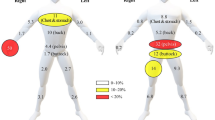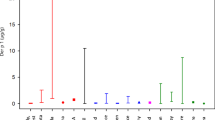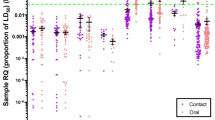Abstract
Agricultural workers manually harvesting tobacco have the potential for high dermal fexposure to pesticides, particularly on the hands. Often gloves are not worn as it hinders the harvesters' ability to harvest the tobacco leaves. To enable harvesters to remove pesticide residue on the hands and decrease absorbed doses, the EPA Worker Protection Standard requires growers to have hand-wash stations available in the field. The purpose of this study was to measure the concentration of acephate residue on the hands of tobacco harvesters, and the effectiveness of hand washing in reducing the acephate residue. Hand-wipes from the hands of 12 tobacco harvesters were collected at the end of the morning and at the end of the afternoon over 2 consecutive days. Each harvester had one hand-wiped prior to washing his hands, and the other hand-wiped after washing his hands with soap and water. In addition to the hand-wipe samples, leaf-wipe samples were collected from 15 tobacco plants to determine the amount of acephate residue on the plants. The average acephate level in leaf-wipe samples was 1.4 ng/cm2. The geometric mean prewash and postwash acephate levels on the hands were 10.5 and 0.4 ng/cm2, respectively. Both prewash (P-value=0.0009) and postwash hand (P-value=0.01) samples were positively correlated with leaf-wipe concentrations. Tobacco harvester position tended to influence hand exposure. Hand washing significantly reduced acephate levels on the hand, after adjusting for sampling period, hand sampled, job position, and leaf-wipe concentration (P-value≤0.0001) with levels reduced by 96%. A substantial amount of acephate was transferred to the hands, and while hand washing significantly reduced the amount of residue on the hands, not all residue was removed.
This is a preview of subscription content, access via your institution
Access options
Subscribe to this journal
Receive 6 print issues and online access
$259.00 per year
only $43.17 per issue
Buy this article
- Purchase on Springer Link
- Instant access to full article PDF
Prices may be subject to local taxes which are calculated during checkout


Similar content being viewed by others
References
Boeniger M., Nishioka M., Carreon T., and Sanderson W. Wipe sampling to assess pesticide exposures on skin: preliminary method evaluation. Presented at the 10th Conference of the International Society for Exposure Analysis, Monterey, CA, October 24–27, 2000.
Brouwer D.H., Boeniger M.F., and Hemmen J.V. Hand wash and manual skin wipes. Ann Occup Hyg 2000: 44 (7): 501–510.
Campbell J.L., Smith M.A. Eiteman M.A., Williams P.L., and Boeniger M.F. Comparison of solvents for removing pesticides from skin using an in vitro porcine model. Am Ind Hyg Assoc J 2000: 61: 82–88.
EPA. Exposure Factors Handbook Vol. 1: General Factors. EPA/600/P-95/002Fa., Office of Research and Development, National Center for Environmental Assessment, US Environmental Protection Agency, Washington, DC, August 1997.
EPA. Worker Protection Standard. Federal Register, 40 CFR Parts 156 and 170, Vol. 57, No. 163. Environmental Protection Agency, Washington, DC, August 21, 1992, pp. 38102–38176.
Fenske R.A., and Lu C. Determination of handwash removal efficiency: Incomplete removal of the pesticide chlorpyrifos from skin by standard handwash techniques. Am Ind Hyg Assoc J 1994; 55 (5): 425–432.
Fenske R.A., Schulter C, Lu C, and Allen E.H. Incomplete removal of the pesticide captan from skin by standard handwash exposure assessment procedures. Bull Environ Contam Toxicol 1998: 61: 194–201.
Fenske R.A., Simcox N.J., Camp J.E., and Hines C.J. Comparison of three methods for assessment of hand exposure to azinphos-methyl (guthion) during apple thinning. Appl Occup Environ Hyg 1999: 14 (9): 618–623.
Geno PW, Camann DE, Harding HJ, Villalobos K, Lewis RG. Handwipe sampling and analysis procedure for the measurement of dermal contact with pesticides. Arch Environ Contam Toxicol 1996: 30: 132–138.
Hornung R.W., and Reed L.D. Estimation of average concentration in the presence of nondetectable values. Appl Occup Environ Hyg 1990: 5: 46–51.
Pelletier O., Ritter L., and Caron J. Effects of skin pre-application treatments and post-application cleansing agents on dermal absorption of 2,4-dichlorophenoxyacetic acid dimethylamine by Fischer 344 rats. J Toxicol Environ Health 1990: 31: 247–260.
Popendorf WJ, Spear RC, Leffingwell JT, Yager J, Kahn E. Harvester exposure to zolone (phosalone) residues in peach orchards. J Occup Med 1979: 21 (3): 189–194.
SAS Institute Inc., SAS/STAT® User's Guide, Version 8. SAS Institute Inc., Cary, NC, 1999: 3884 pages.
Wester R.C., Maibach H.I., Bucks D.A.W., McMaster J., Mobayen M., Sarason R., and Moore A. Percutaneous absorption and skin decontamination of PCB's: in vitro studies with human skin and in vivo studies in the rhesus monkey. J Toxicol Environ Health 1990: 31: 235–246.
Winterlin W.L., Kilgore W.W., Mourer C., Schoen S.R. Worker reentry studies for captan applied to strawberries in California. J Agric Food Chem 1984: 32: 664–672.
Zwieg G, Gao R, Popendorf WJ. Simultaneous dermal exposure to captan and benomyl by strawberry harvesters. J Agric Food Chem 1983: 31: 1109–1113.
Acknowledgements
We thank Mark Boeniger and Aaron Jones of the National Institute for Occupational Safety and Health, and Robert McRackan of the North Carolina State University for technical assistance, and Fran Guerra of the National Institute for Occupational Safety and Health for her administrative assistance.
Author information
Authors and Affiliations
Corresponding author
Rights and permissions
About this article
Cite this article
Curwin, B., Hein, M., Sanderson, W. et al. Acephate exposure and decontamination on tobacco harvesters' hands. J Expo Sci Environ Epidemiol 13, 203–210 (2003). https://doi.org/10.1038/sj.jea.7500271
Received:
Accepted:
Published:
Issue Date:
DOI: https://doi.org/10.1038/sj.jea.7500271
Keywords
This article is cited by
-
Review of methods to determine hand surface area of children less than six years old: a case study
Environmental Geochemistry and Health (2021)
-
Community-based intervention to reduce pesticide exposure to farmworkers and potential take-home exposure to their families
Journal of Exposure Science & Environmental Epidemiology (2009)
-
Health risks in tobacco farm workers—a review of the literature
Journal of Public Health (2007)



